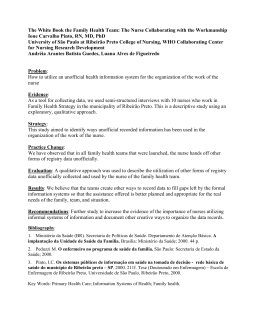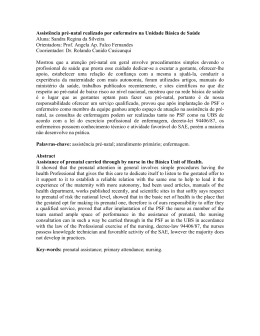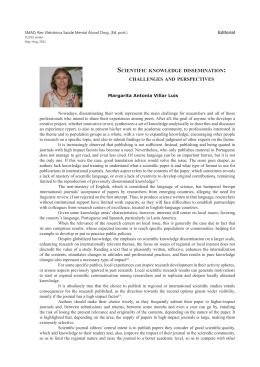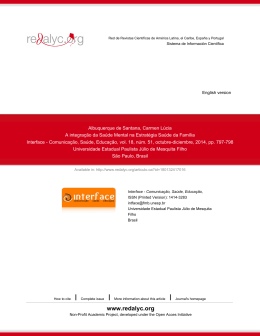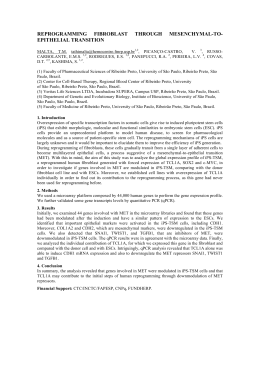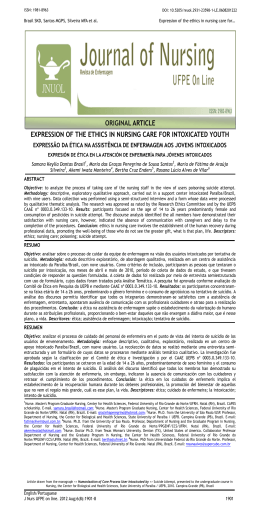10 SMAD, Rev. Eletrônica Saúde Mental Álcool Drog. Original Article 11(1):10-8 Jan.-Mar. 2015 DOI: 10.11606/issn.1806-6976.v11i1p10-18 Access to information on diagnosing and hospitalizing an individual with mental illness1 Emanuele Seicenti de Brito2 Carla Aparecida Arena Ventura3 The aim of this study was to identify what health care professionals working in psychiatric hospitals think about access to information concerning the disease and hospitalization. Descriptive research using a qualitative approach was conducted in a psychiatric hospital. A total of 33 health care professionals with experience of hospitalizing and directly caring for patients participated in the study. The data were obtained using a semi-structured interview and participant observation and are presented in thematic categories: “The patient and the information provided: hospital norms and routines”; “The role of health care professionals in providing patients with information”; “Lack of information and its causes”. It was concluded that the access those with mental disorders have to information about their disorder and treatment is limited, showing the need to encourage awarenessraising activities in health care professionals about their role in providing information, to ensure the right to information is effectively guaranteed. Descriptors: Right to Health; Patient Rights; Access to Information; Mental Health; Hospitalization; Mentally Ill Persons. 1 Paper extracted from Master Dissertation “O Direito Humano à Saúde Mental: compreensão dos profissionais da área” presented to Escola de Enfermagem de Ribeirão Preto, Universidade de São Paulo, SP, Brazil. Supported by Conselho Nacional de Desenvolvimento Científico e Tecnológico (CNPq). This research received honorable mention on XII Encontro de Saúde Mental 2012, Ribeirão Preto, SP, Brazil. 2 Doctoral Student, Escola de Enfermagem de Ribeirão Preto, Universidade de São Paulo, PAHO/WHO Colaborating Centre for Nursing Research Development, Ribeirão Preto, SP, Brazil. 3 PhD, Associate Professor, Escola de Enfermagem de Ribeirão Preto, Universidade de São Paulo, PAHO/WHO Colaborating Centre for Nursing Research Development, Ribeirão Preto, SP, Brazil. Correspondence Carla A. Arena Ventura Universidade de São Paulo. Escola de Enfermagem de Ribeirão Preto Departamento de Enfermagem Psiquiátrica e Ciências Humanas Av. Bandeirantes, 3900 Bairro: Monte Alegre CEP: 14040-902, Ribeirão Preto, SP, Brasil E-mail: [email protected] Brito ES, Ventura CAA. 11 O acesso às informações sobre diagnóstico e internação à pessoa com transtorno mental O objetivo deste trabalho foi identificar o que os profissionais de saúde que trabalham em um hospital psiquiátrico pensam sobre o acesso às informações, sobre a doença e a internação. Foi realizada uma pesquisa descritiva, com abordagem qualitativa, em um hospital psiquiátrico. Participaram do estudo 33 profissionais que vivenciam o processo de hospitalização e cuidados diretos ao paciente. Os dados foram obtidos mediante entrevista semiestruturada e observação participante e apresentados nas categorias temáticas: “O paciente e as informações prestadas: normas e rotinas do hospital”; “O papel dos profissionais de saúde no oferecimento de informações aos pacientes”; “A insuficiência das informações e suas causas”. Conclui-se que o acesso às informações pelas pessoas com transtornos mentais sobre seu transtorno e tratamento é limitado, o que evidencia a necessidade de promoção de ações de conscientização dos profissionais de saúde a respeito de seu papel na prestação de informações, para que assim o direito à informação seja garantido efetivamente. Descritores: Direito à Saúde; Direito dos Pacientes; Acesso à Informação; Saúde Mental; Hospitalização; Pessoas Mentalmente Doentes. El acceso a las informaciones sobre diagnóstico e internamiento de la persona con trastorno mental El objetivo de este trabajo fue identificar, lo que los profesionales de la salud que trabajan en un hospital psiquiátrico piensan sobre el acceso a las informaciones, sobre la enfermedad y el internamiento. Fue realizada una investigación descriptiva, con un abordaje cualitativo, en un hospital psiquiátrico. Participaron en el estudio 33 profesionales que se ocupaban del proceso de la hospitalización y cuidados directos al paciente. Los datos fueron obtenidos mediante entrevista semi-estructurada y observación activa y presentados en las categorías temáticas: “El paciente y las informaciones prestadas: normas y rutinas del hospital”; “El papel de los profesionales de la salud en el ofrecimiento de información a los pacientes”; “la insuficiencia de las informaciones y sus causas”. Se concluye que el acceso a la información de las personas con trastornos mentales sobre su trastorno y tratamiento es limitado, lo que evidencia la necesidad de promover acciones de concienciación de los profesionales de la salud al respecto de su papel en la prestación de informaciones, para que así el derecho a la información sea garantizado efectivamente. Descriptores: Derecho a la Salud; Derechos del Paciente; Acceso a la Información; Salud Mental; Hospitalización; Pessoas Mentalmente Doentes. www.eerp.usp.br/resmad SMAD, Rev. Eletrônica Saúde Mental Álcool Drog. Jan.-Mar. 2015;11(1):10-8. Introduction Method The right of access of those with mental illness to as much information as possible on disease and treatment is guaranteed in a variety of legal instruments (Federal Law 10.216/01; Ministry of Health Ordinance nº 1286/1993; São Paulo state Law 10.241/1999; Federal Medical Council Resolution 1.407/1994; Federal Medical Council Resolution 1.598/2000, Brazilian Health Care Users’ Charter of Rights). The 2º article, item VI, of São Paulo state Law 10.241 of 1999 (1) states that it is the right of health care service users in the state of São Paulo to receive clear, objective and comprehensive information on: diagnostic hypotheses and confirmed diagnoses; exams carried out; therapeutic actions; risks and benefits of diagnostic measures and proposed treatments; expected duration of proposed treatment; exams and behavior to be undergone; the purpose of the materials collected for examination; diagnosis and treatment alternative in available there or in other services. The second principle of the Brazilian Health Care Users’ Charter of Rights guarantees the citizen access to appropriate and effective treatment, aiming at improvements to the services provided, guaranteeing information on state of health to family members and/or companions in a clear, objective, responsible and understandable way, adapted to cultural conditions and respecting ethical limits on the part of the health care team concerning diagnostic hypotheses and confirmed diagnoses, among other information (2). Thus, the right to information concerning diagnosis is a means at the patient’s disposal to gain knowledge of and make decisions about what they are experiencing (3-4). Lack of information can lead to abusive actions and it is therefore necessary for the patient to be aware of their diagnosis and rights in order to demand them and demand the best treatment, exercising their rights effectively. Thus, this article seeks to discover the thoughts of health care professionals working in psychiatric hospitals concerning access to information on disease and hospitalization. This was descriptive research with a qualitative approach to the data. The qualitative approach is deemed appropriate when the phenomenon in question is complex, of a social nature and does not lend itself to quantification. It seeks to interpret the feelings and meanings – of a psychological and socio-anthropological nature – that individuals bring to and attribute to concerning the multiple phenomena belonging to the field in which the disease-illness process occurs (5). The data were collected using an in-depth, semi-open interview that was recorded. This technique was chosen to explore the topic based on the search for the informants’ information, perceptions and experiences, which the interviewer analyzes and presents in a structured way (6). It is of great use in descriptive studies that seek to map a situation or field of analysis, to describe or focus on a specific context. The semi-structured interview model has its origins in a guide-script of questions covering what is if interest to the research. Thus, the script to interview the professionals was drawn up based on our objectives for the study, focusing on the questions: What information do you provide the patient with during hospitalization? Do you think this information is sufficient? In order to be included in the study, subjects had to be participants in the process of hospitalizing patients and to provide direct care to them whilst hospitalized, as well as agreeing to participate by signing an informed consent form. Professionals were chosen as the subject of this study as they play an important role in guaranteeing patients’ right. From this perspective, in order to ensure the law is complied with, an in order to provide a service that takes into consideration the humanity of the individual cared for, it was necessary that the professionals involved be constantly aware of patients’ rights as users of the health care system. Of the 92 health care professionals working in the location chosen, 33 agreed to take part: five doctors, seven nurses, 14 nursing assistants, three nursing technicians, two social care assistants, one psychologist and one occupational therapist. The majority were female (63.63%), married (51.51%), nursing assistants (42.43%), www.eerp.usp.br/resmad 12 Brito ES, Ventura CAA. having spent between one month and five years working in the profession (63.64%) and having spent between one month and five years working there (69.7%). Going beyond the interview, participant observation complements the methodology. It is often used in the qualitative approach, as it enables the data obtained in the interview to be corroborated, or not, as the subjects’ statements are not always compatible with their behavior. “Particiant observation gives the opportunity to unite the object and its context, in counterpoint to the principle of isolation in which we were formed”(7). The three essential stages of participant observation were followed (8): 1ª) The researcher approaches the group studied; 2ª) obtaining an overall view of this group. This stage involved studying official documents; reconstituting the history of the group and the location; observing daily life; noting the key individuals and conducting non-directed interviews with those who were able to aid in understanding this reality; 3ª) Systemizing and organizing the data (7). This stage of the research took place over the course of a month, between 06/12/2010 and 07/01/2011, occurring four times a week lasting approximately 3 hours per visit. Visits alternated between the morning, afternoon and night shifts, different days of the week and in all of the wings of the hospital studied. Observation enabled an immersion into the reality of the universe studied and to get closer to the subjects. Field diaries were used to record observations. The study was approved by the Ethics Committee of the Nursing School, Ribeirão Preto, report nº1056/2009 and all ethical precepts of the National Health Council Resolution 196/96 were respected. Subjects were informed of the objectives of the study and confidentiality and anonymity were guaranteed, subjects being identified only through a letter: Nurse-N; Nursing Assistant-NA; Nursing TechnicianNT, Doctor-D; Social Care Assistant-SA; Psychologist-P and Occupational Therapist-OT, and the number of their interview. Data were collected between December 2010 and January 2011 in a psychiatric hospital in São Paulo state. Content analysis by thematic categories(9) was used to analyze the data. The categories www.eerp.usp.br/resmad 13 were constructed according to the themes that emerged from the text. The material was explored in three stages (9): pre-analysis, in which the data were transcribed and organizes; in the stage of exploring the material, the data were organized according to categories and thematic sub-categories, repeatedly revised and continuously codified. The interview content and the outlines defining meaning were read repeatedly and in detail in order to meet the objectives of the study. Finally, the third stage, treating and interpreting the results analyzed, supported by the literature on the object of the study and by the observation data, culminating in the final considerations. After the data had been systemized, the following thematic categories were identified: “The patient and the information provided: hospital norms and routines”; “The role of health care professionals in providing patients with information”; “Lack of information and its causes”. Results and discussion Concerning the information provided to the patient, the majority of those interviewed from the nursing team stated that they merely provided information on hospital norms and routines. Institution norms and routines (NA24). We give information on the hospital routines (N12). When they are hospitalized their family are informed of the patient’s situation and sign the consent form. Everything you can and can’t do in here, the patient enters here knowing what they is and is not within their rights, we don’t normally have that much information (NA31). we tell them that they are in a psychiatric hospital, that there are some restrictions here, it’s different from other hospitals, from clinical hospitals. For example, here there are things they can’t do and there are things they will be able to do, that therapy is essential to their treatment, the schedules for medications, meal times, we explain all of this when they are hospitalized (NA21). Within the information necessary for the patients, the health care professionals, especially members of the nursing team, focus on the hospital norms and routines. They believe that this information is of the most use to the patient as, in the end, they have to follow them correctly to maintain the organization in the care process. SMAD, Rev. Eletrônica Saúde Mental Álcool Drog. Jan.-Mar. 2015;11(1):10-8. The hospital’s model of organization has bureaucratic characteristics typical of such organizational structures(10), based on the principles of discipline, specialization of functions, hierarchy, legal authority and formalization. This model of organization is one of the most efficient, as actions are defined by norms, leading to disciplined behavior on the part of the individuals. It should be emphasized that formalizing procedures through rules is of importance in the hospital environment, it being necessary to maintain order for the hospital to function. Excessive bureaucracy, however, causes dysfunction and can lead to calcification in the organization, characterized by clinging totally to norms and routines (11). Certain bureaucratic dysfunctions, then, were also identified in the location studied: internalizing rules and clinging exaggeratedly to them; excessive formalism and paperwork; resistance to change; depersonalized relationships; categorization based on the decisorial process; over-conformity to routines and procedures; exhibiting marks of authority; difficulty dealing with clients and conflict with the public (12). The professionals were found to cling to the established norms and to their functions within the institution in such a way that it also resulted in bureaucratizing care of mentally ill patients. Talking about medication, side effects, that kind of thing, we ask them to talk with the doctor, even though we know about these things, sometimes we say something and then the doctor comes along and says you shouldn’t have said that ,you shouldn’t have said that the medication has that side effect, as the patient won’t want to take it, ok? So we always ask them to talk about these things with the doctor (N12). For the participants, the doctor is the most important member of the team: It’s the hospital, the doctor is the head, it’s who changes, changes back, prescribes, knows what the patient does or doesn’t have, the patient comes and asks what they are taking defakane for. Even if I know, I say I don’t; tell them to see the doctor, the doctor will tell you what it’s for, so here the doctor is everything, the head of the hospital, without the doctor the hospital wouldn’t function (NA31). According to the research subjects, it is the nurses’ job to receive and care for the patient: It is the nurse’s job to receive the patient and family, because the family and the patient…they are not usually familiar with the institution, they don’t know how it works, what’s going to happen to them here, so it’s the nurse’s job to receive the family and the patient. Our first function here when we receive the patient when they are hospitalized is to make them feel comfortable (N1). I see my role as totally necessary, because although they have to have an interview with the doctor first, and the doctor might ask, for example, what things are like for him at home, then the family talk, and so he prescribes a medication, for another symptom another medication, out part is more humane, not that My role is very bureaucratic, we have a lot of paperwork, the doctor isn’t humane, but we receive them, explain for them more than there should be, I have direct contact with the patients, the importance of hospitalization, we hug them, we humanize I like to go in and talk with the patient, dialogue, but we are very that patient, not treating them as just another person occupying restricted by our roles, as head nurse, there’s a lot of paperwork a bed. That’s the role of nursing (N2). and, when you come down to it, little care, but whenever I can I have direct contact with the patient (E26). The professionals were seen to be clear on their functions in the care process, established by internal norms. Likewise, over-conformity to routines and procedures lead them to encounter difficulties in making changes aiming at improving the work process and even increasing their skills, as they cling too closely to carrying out their functions predetermined by regulations. This dysfunction was also evident when discussing the role of health care professionals in providing patients with information. According to the interviewees, information on treatment should only be provided by the doctor. The statements demonstrate some of the above mentioned functions such as exhibiting authority: www.eerp.usp.br/resmad It is also the nurse’s role to supervise the nursing technicians and assistants. My role is to supervise the assistants, seeing if the flow is going right, if everything is ok, if the patients need anything, managing the workers. I’m responsible for everything that happens to the patient in there (N12). In addition to receiving and looking after patients and supervising, as a member of the health care team, it is also the nurse’s job to; participate in drawing up, executing and evaluating health care plans: prescribing medications previously established in public health care problems in the routine approved by the health care institution; participating in individual and groups comprehensive health care programs and activities, especially for priority and high risk patients; participating in health education programs and 14 Brito ES, Ventura CAA. activities, aiming to improve the health of individuals, families and the population in general; participating in health care personnel training and development programs, especially in continuous education programs; participating programs promoting health and safety and preventing work-related accidents and diseases; participating in drawing up and instituting patient referral and counter referral systems at different levels of health care and participate in developing technology appropriate to health care (13-14). The nursing technicians and assistants summarize their roles in the patient’s care routine. Awe give medicine, … provide care, cure, sometimes we also talk with the patients, support them psychologically, we end up doing a bit of everything. (laughter) (NT5). My role is… to welcome that person and do my best to care for them (NA22). I think it’s a very important role we have, why? Because the doctor is not always in contact with the patient. So, those of us who have direct contact, who see everything, who analyze, who see everything, whatever the patient is feeling, the differences, we pass all this on to the doctor, so I think our role, what we have to do, is very important (NA8). My role? To care. Overall care for the patient, total care, helping them dress, helping them with self-care... (NA17). Decree nº 94.406/87 which regulates nursing activities states that it is the role of the nursing technician to assist the nurse: in planning, programming, guiding and supervising nursing assistant activities; in providing direct nursing care to seriously ill patients; in preventing and controlling communicable diseases and in epidemiological control programs; in systematically preventing and controlling hospital infection and the systematic prevention and control of possible physical harm to patients during care (13). Moreover, it is the function of the Nursing assistant to prepare the patient for consultations, exams and treatment; to observe, recognize and describe signs and symptoms as far as they are qualified to; to perform specifically prescribed or routine treatments and other nursing activities such as: administering some medications; controlling water and applying bandages; giving oxygen, nebulization, enteroclysis, enema and heat or cooling; monitoring patients and carriers of communicable diseases; conducting and interpreting tests to support diagnosis; collecting material for laboratory exams; carrying out disinfection and sterilization(13). www.eerp.usp.br/resmad 15 It also falls to the assistant to care for the patient’s hygiene and comfort and their safety, including: feeding or helping them to feed themselves; looking after cleanliness and tidying the health care unit’s material, equipment and facilities; forming part of the health care team; participating in health care education, even giving patients post-consultation guidance about complying with Nursing and medical prescriptions and carrying out routine work connected with patient discharge. These activities are only conducted under the supervision, guidance and direction of the nurse (13). However, beyond receiving and caring for individuals with mental disorders, the nursing team should also actively participate in the decision making process regarding the patient, side by side with the multi-disciplinary team formed of doctors, psychologists, social care assistants and occupational therapists. “With the psychiatric reform, the theoretical-practical field of mental health care to be redefined, requiring the nurse to abdicate their role of monitoring lunatic asylum clients, becoming a member of an inter-disciplinary team, an essential element for intervening in the rehabilitation of subjects with mental health disorders. At this juncture, one of the main roles of nurses is related to creating bonds with patients, receiving them reception and performing the most humane and effective interventions consonant with the concrete needs of patients and their families, always seeking to understand these people’s needs and facilitate their social integration, preserving the mental health of the family group”(15). As they are closer to the patient’s day-to-day life in the hospital, health care professionals from the nursing team have countless opportunities to provide the patient with closer guidance on information on diagnosis and medication. Even so, their statements show that they do not believe themselves apt to provide such information We aren’t the right professional to be giving this guidance (NA24). So, we only say what nurses are supposed to say, basic guidance (NA13). In this situation, results of the study evaluating the degree of knowledge on medical treatment indicated “insufficient educational activities towards patients on the part of health care SMAD, Rev. Eletrônica Saúde Mental Álcool Drog. Jan.-Mar. 2015;11(1):10-8. professionals, especially nurses, being the professional with the most opportunities to guide and teach patients, compared with other professionals on the tem, although the essential roles doctors and pharmacists play in this activity (16)”. With regards to medication treatment, the professionals interviewed believed that knowing about the medication may lead to non-adherence to treatment, found that professionals placed great importance on communicating with the families of those with mental disorders; however, they revealed that such communication is almost impossible, due to lack of time in which to develop it(21). The second explanation for the lack of information was comprehension difficulties of individuals with mental disorders, They would be sufficient according to the patient’s situation Sometimes, we can’t talk too much about medication, as on being hospitalized, depending on how the patient is hospital- then the patient won’t accept the treatment, refuses it, doesn’t ized, he might not even realize what is happening, in reality, there want to be hospitalized, so if you talk about the medication he is no way to give him this information, depending on the way he will take and what it’s for, it is another restriction that he’s not is being hospitalized (AN17). going to want (AN20). In contrast to the opinion of the majority of interviewees, a review of the literature on the effect of lack of and/or misinformation in patients and families is an extremely negative factor for those with mental disorders, this being a possible determinant of non-adherence to treatment (16-20). One of the participants highlighted the importance of receiving information: Whatever his reason for being here is, I try to give him an idea of what problem he has at that moment, why he’s feeling those symptoms, if there is a diagnosis, clarify what his diagnosis is. It is always important to pass this on to the patient so he doesn’t feel insecure, so he doesn’t feel that no one explains anything to him, or that he doesn’t know what’s happening. So, I give the guidance on the medication, what medicines we’re giving him, what each one does, this creates a strong bond at the beginning of the treatment, if you do this, the patient will cooperate much more in the treatment, he’ll accept the medicines more easily and trust you more. If he thinks the medicine is not working, he’ll tell you, he’ll have much more trust in you and so you’ll be more successful treating him, as it’s much easier if both are pulling in the same direction (D30). Although there is an intention to “inform”, according to the majority of participants in this research, the information was not sufficient. The subjects explained “lack of information” through two motives: the first being a lack of time for individualized care. I think it won’t happen yet, more things are needed, a whole set of things such as time, time is always so short, I think we need more time, but conditions today are atypical, even in pharmacology, we give medication much more than we care for the patient (D6). In a study conducted in a large, closed psychiatric institute on communication between team members, patient and family, the researchers www.eerp.usp.br/resmad The interviewees spoke of the patients’ difficulty understanding at the time of hospitalization; however, the information should be provided throughout the process of hospitalization; when a bond has been established between patient and health care professional it is easier for patients with mental disorders to understand their diagnosis and treatment. Mental disorders bring with them communication difficulties, it is down to the professionals to provide a welcoming environment and maintain a relationship of trust with the patient in order for him to understand his situation better and collaborate more effectively with the treatment (22). Conclusion Federal law 10.216 de 2001 sets out the rights of those with mental illness: to receive more information on their illness and treatment. This research, then, sought to identify the thoughts of health care professionals on the right of the patient to receive information on their disorder and treatment, as these subjects play a significant role in providing information and guaranteeing patients’ rights. After analyzing the data obtained, it can be concluded that the access of individuals with mental disorders to information on their disorder and its treatment is limited. The doctor was the only professional recognized as able to provide such information, it being the role of the other professional to provide information limited to the norms and routines of the hospital. Although this information was duly provided, it was seen as insufficient by the majority of subjects, due to a lack of time for individualized care and to the 16 Brito ES, Ventura CAA. difficulty those with mental disorders had in understanding it. We suggest encouraging awareness raising activities aimed at health care professionals on their role in providing information, in order to ensure that the right information is effectively guaranteed. Moreover, research redirecting the focus onto discovering what users themselves and their families think about the right to receive information about their disorder and treatment. References 1. Lei estadual n. 10.241, de 17 de março de 1999 (BR). Dispõe sobre os direitos dos usuários dos serviços e das ações de saúde no Estado e dá outras providências. [acesso 2 fev 2011]. Disponível em: http://www.saude.sp.gov.br/resources/profissional/acesso_rapido/gtae/saude_ da_mulher/lei_10241_direi tos_usuarios.pdf 2. Carta dos direitos dos usuários da saúde. Brasília: Ministério da Saúde; 2006. 3. Chaves PL, Costa VT, Lunardi VL. A enfermagem frente a direitos de pacientes hospitalizados. Texto Contexto Enferm. 2005;14(1):38-43. 4. Leite RAF. Direito à informação em saúde: análise do conhecimento do paciente acerca de seus direitos [dissertação de mestrado]. Ribeirao Preto (SP): Escola de Enfermagem de Ribeirão Preto da Universidade de São Paulo; 2010. 118 p. 5. Botega NJ, Turato ER. Pesquisa no hospital geral: primeiros passos. In: Botega NJ. Prática psiquiátrica no Hospital Geral: interconsulta e emergência. Porto Alegre: Artmed; 2006. 6. Duarte JAM. Entrevista em profundidade. In: Duarte JAM. Métodos e técnicas de pesquisa em comunicação. São Paulo: Atlas; 2005. 7. Queiroz DT, Vall J, Souza AMA, Vieira NFC. Observação participante na pesquisa qualitativa: conceitos e aplicações na área da saúde. Rev Enferm UERJ. 2007;15(2):276-83. 8. Richardson RJ. Pesquisa social: métodos e técnicas. São Paulo: Atlas; 1999. 9. Bardin L. Análise de conteúdo. Lisboa: Edições 70; 1995. 10. Weber M. Os fundamentos da organização burocrática: uma construção do tipo ideal. In: www.eerp.usp.br/resmad 17 Campos E. Sociologia da burocracia. Rio de Janeiro (RJ): Zahar; 1978. 11. Timeni S. Teoria da Burocracia Weberiana e a relação com a Saúde Pública do RN. [acesso 30 jun 2011]. Disponível em: http://www.administradores.com.br/informe-se/artigos/teoria-da-burocracia-weberiana-e-a-relacao-com-asaude-publica-do-rn/51758/. 12. Motta FCP. Teoria geral da administração. São Paulo: Pioneira; 1991. 13. Decreto n. 94.406, de 8 de junho de 1987 (BR). Regulamenta a Lei 7.498, de 25 de junho de 1986, que dispõe sobre o exercício da Enfermagem, e dá outras providências. [acesso 5 jun 2011]. Disponível em: http://www2.camara.gov.br/legin/fed/decret/1980-1987/decreto-94406-8-junho-1987-444430-publicacaooriginal-1-pe.html 14. Bocchi SCM. Characterization of nurses daily activities at an university hospital. Rev. Latino-Am. Enfermagem. 1996;4(21):41-58. 15. Jorge MSB, Freitas CHA, Luz, PM, Cavaleiro LMM, Costa RF. Enfermagem na atenção sistemática de saúde à família de pessoas com transtorno mental: estudo bibliográfico. Rev RENE. 2008;9(1):129-36. 16. Vianna CO, Opitz SP, Miasso AI, Linhares JC, Cassiani, SHB. Segurança do paciente hospitalizado: avaliação do grau de conhecimento sobre terapêutica medicamentosa. Esc Anna Nery. 2004;8(2):235-42. 17. Silva T, Schenkel EP, Mengue SS. Nível de informação a respeito de medicamentos prescritos a pacientes ambulatoriais de hospital universitário. Cad Saúde Pública. 2000;16(2):449-55. 18. Santos JLF, Furegato ARF, Osinaga VLM. Condicionantes do conhecimento do diagnóstico médico em três serviços psiquiátricos. Rev Enferm UFRJ. 2010;18(1):80-5. 19. Miasso AI, Cassiani SHB. Administração de medicamentos: orientação final de enfermagem para a alta hospitalar. Rev Esc Enferm USP. 2005;39(2):136-44. 20. Carvalho VT. Erros na medicação e consequencias para profissionais de enfermagem e clientes: um estudo exploratório. Rev Latino-Am Enfermagem. 2002;10(4):523-9. 21. Waidman MAP, Koga M, Stefanelli MC. Utilização da comunicação na prática da equipe 18 SMAD, Rev. Eletrônica Saúde Mental Álcool Drog. Jan.-Mar. 2015;11(1):10-8. multiprofissional de uma instituição psiquiátrica. Cogitare Enferm. 1997;2(1):82-5. 22. Salles MM, Barros S. Reinternação em hospital psiquiátrico: a compreensão do processo saúde/doença na vivência do cotidiano. Rev Esc Enferm USP. 2007;41(1):73-81. Received: Mar. 12th 2014 Accepted: Mar. 3rd 2014 www.eerp.usp.br/resmad
Download
